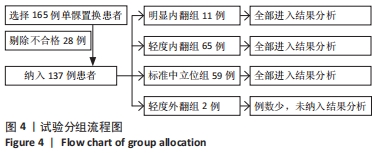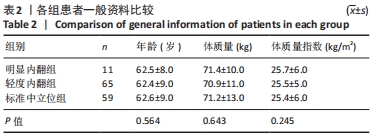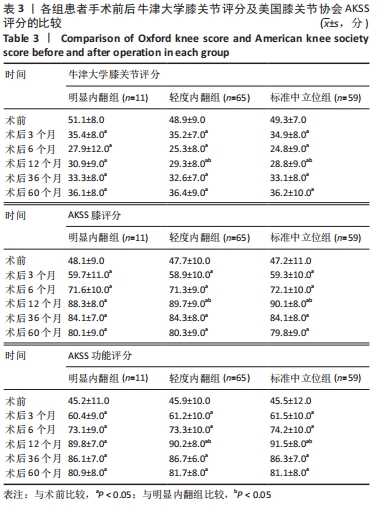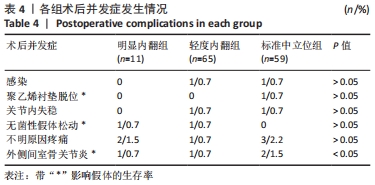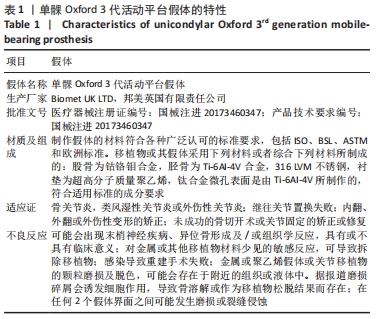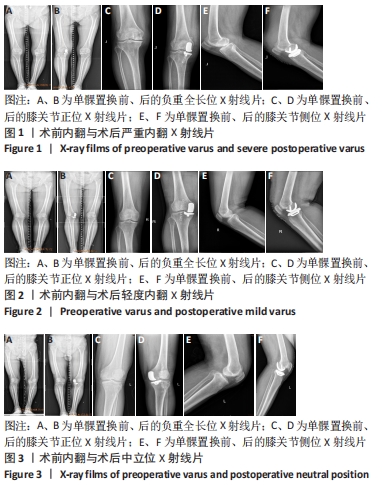[1] 孙海宁,于秀淳,付志厚,等.单髁关节置换治疗膝内侧骨性关节炎的中短期临床分析[J]. 生物骨科材料与临床研究,2015,12(2):33-36.
[2] 鲁洋,邢欣,吕骥,等.内侧间室膝关节骨关节炎的形态学构成分析[J].中华创伤骨科杂志,2019(5):372-377.
[3] THIENPONT E, SCHWAB P, CORNU O, et al. Bone morphotypes of the varus and valgus knee. Arch Orthop Traum Su. 2017;137(3):393-400.
[4] 冯健,班吉鹤,高均宏,等.单髁置换治疗对膝关节单间室骨关节炎的临床疗效[J].浙江创伤外科,2021,26(3):535-536.
[5] 李慧彬,张延辉,王振海.膝骨关节炎单髁置换术的现状与进展[J].牡丹江医学院学报,2021,42(3):171-173.
[6] 陶可,林剑浩,李虎.单髁关节置换术治疗膝骨关节炎的研究进展[J].中华骨与关节外科杂志,2019,12(2):150-155.
[7] 苏军,孙长英.单髁置换治疗膝关节前内侧单间室骨性关节炎[J].中国组织工程研究,2017,21(19):3080-3087.
[8] KIEVIT AJ, KUIJER PPF, DE HAAN LJ, et al. Patients return to work sooner after unicompartmental knee arthroplasty than after total knee arthroplasty. Kssta. 2020;28(9):2905-2916.
[9] 张启栋,郭万首,刘朝晖,等.内翻畸形膝关节骨关节炎外侧间室软骨磨损的危险因素分析[J].中华外科杂志,2015,53(5):357-361.
[10] 甘浩然,程楷,赵文胜,等.膝骨关节炎中骨性力线改变的影像学及临床研究[J].实用骨科杂志,2019,25(8):709-712.
[11] 王俊.单髁关节置换术治疗膝关节内侧间室骨性关节炎疗效观察[J].实用中西医结合临床,2020,20(5):74-76.
[12] 赵东方,孔祥朋,王毅,等.第三代Oxford单髁假体安放位置对人工单髁关节置换术近期疗效的影响[J].中国修复重建外科杂志,2018,32(12):1518-1523.
[13] 万伏银,郭万首.单髁假体的演变及现状[J].中国组织工程研究,2017,21(23): 3753-3759.
[14] CRAIK D, EL SHAFIE SA, SINGH VK, et al. Revision of unicompartmental knee arthroplasty versus primary total knee arthroplasty. J Arthroplasty. 2015;30(4):592-594.
[15] 张启栋,郭万首,刘朝晖,等.单髁与全膝关节置换术治疗高龄患者的配对病例对照研究[J].中华关节外科杂志(电子版),2017,11(1):4-8.
[16] KENNEDY JA, BURN E, MOHAMMAD HR, et al. Lifetime revision risk for medial unicompartmental knee replacement is lower than expected. Kssta. 2020:1-7.
[17] FORNELL S, PRADA E, BARRENA P, et al. Mid-term outcomes of mobile-bearing lateral unicompartmental knee arthroplasty. Knee. 2018;25(6):1206-1213.
[18] 吴东,杨敏之,曹正,等.膝关节单髁置换术研究进展[J].中国修复重建外科杂志,2020,34(2):145-150.
[19] 张启栋,郭万首,岳聚安,等.术前外翻应力位X线片预测Oxford单髁关节置换术后下肢力线变化的临床研究[J].中国骨与关节杂志,2016,5(10):747-751.
[20] BRUNI D, IACONO F, RUSSO A, et al. Minimally invasive unicompartmental knee replacement: retrospective clinical and radiographic evaluation of 83 patients. Kssta. 2010;18(6):710-717.
[21] 沙宇,韩晓峰,胡彬,等.活动平台与固定平台单髁置换术后下肢力线的矫正效果比较[J].骨科临床与研究杂志,2019,4(6):329-332.
[22] KENDRICK B, SIMPSON DJ, KAPTEIN BL, et al. Polyethylene wear of mobile-bearing unicompartmental knee replacement at 20 years. J Bone Joint Surg Br. 2011;93(4):470-475.
[23] KENNEDY JA, MOLLOY J, JENKINS C, et al. Functional outcome and revision rate are independent of limb alignment following Oxford medial unicompartmental knee replacement. J Bone Joint Surg. 2019;101(3):270-275.
[24] KIM S, BAE J, LIM HC. Factors affecting the postoperative limb alignment and clinical outcome after Oxford unicompartmental knee arthroplasty. J Arthroplasty. 2012;27(6):1210-1215.
[25] ZHANG Q, ZHANG Q, GUO W, et al. Risk factors of postoperative valgus malalignment in mobile-bearing medial unicompartmental knee arthroplasty. Arch Orthop Traum Su. 2019;139(2):241-248.
[26] MULLAJI AB, SHAH S, SHETTY GM. Mobile-bearing medial unicompartmental knee arthroplasty restores limb alignment comparable to that of the unaffected contralateral limb. Acta Orthop. 2017;88(1):70-74.
[27] KIM KT, LEE S, KIM TW, et al. The influence of postoperative tibiofemoral alignment on the clinical results of unicompartmental knee arthroplasty.Knee Surg Relat Res. 2012;24(2):85.
[28] VASSO M, DEL REGNO C, D’AMELIO A, et al. Minor varus alignment provides better results than neutral alignment in medial UKA. Knee. 2015;22(2):117-121.
|

